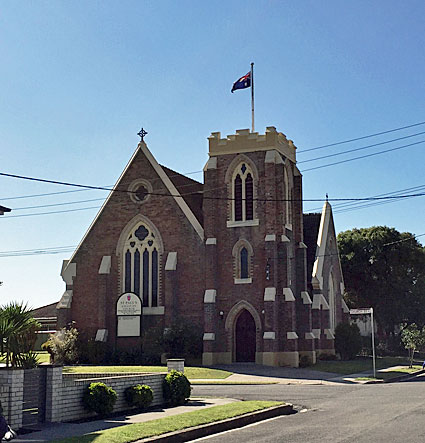
St Paul's Anglican Church, Stockton:
exterior from the south-west
[photograph by Mark Quarmby (28 September 2015)]

St Paul's Anglican Church, Stockton:
exterior from the south-west
[photograph by Mark Quarmby (28 September 2015)]
Historical and Technical Documentation by Kelvin Hastie
© OHTA, 2015 (last updated January 2016)
The first St Paul's Church, constructed in timber and opened on 13 September 1870, originally housed a small barrel organ previously located in Christ Church, Newcastle.1 Rushworth suggests that this instrument may have been the small tracker organ (possibly by Flight & Son, London, 1835), later located at Sacred Heart Catholic Church, Hamilton and sold in 1980 to the Revd Michael Johnson, who moved the instrument among the various Uniting Church parishes where he served in the latter years of his ministry. This instrument was relocated to the Powerhouse Museum, Sydney, in 1992.2
The present St Paul's dates from 1890 and is in early pointed Gothic style, built in brick, with a tower containing a belfry and ringing chamber. Built to the designs of Messrs. George Sanders & Son of Newcastle, the plan is cruciform, the organ being located in the south transept. The total length of the building is 80 feet and there are two entrances, one under the tower in the south-west corner, the other on the northern wall at the western end of the building. The nave is capable of seating 350.3
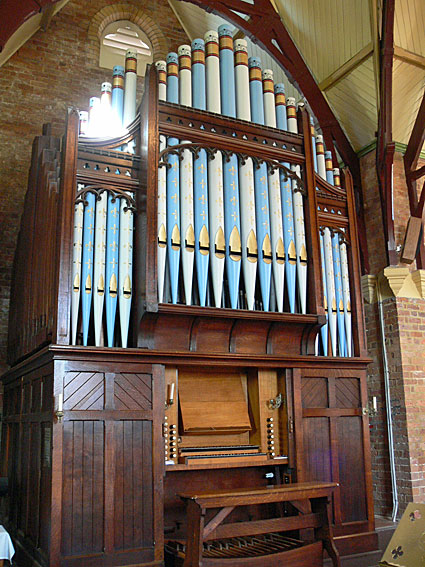
St Paul's Anglican Church, Stockton:
the Nicholson & Co. organ
[photograph by John Maidment (28 September 2015)]
The present organ, built in 1891 by Nicholson & Co., of Palace Yard, Worcester, for All Saints' Anglican Church, Singleton, was installed at Stockton in 1911, where it displaced the earlier small tracker organ. The Nicholson instrument survives in near-original condition today, John Stiller noting during his documentation of June 1981 that the only significant changes have been the addition of tuning slides to open metal pipes, the removal of the original display pipe decorations, the addition of the tremulant (now disconnected) and the removal of most of the hand-blowing apparatus. In his statement of significance, Stiller noted that 'the instrument represents a largely unaltered and rare example of the work of a prominent nineteenth-century English organbuilding firm'. He also commented on the following features:
All of the original pipework has been retained, and has the interesting feature that all open metal pipes with a body length of less than one foot are made of spotted metal, those with a length greater than four foot are of zinc, and the remainder are of plain metal.
- The original console has been preserved and contains original fittings such as stopknobs, stop labels, keyboards, keyboard cheeks, pedalboard, composition pedals, nameplate of builder and Swell shutter control.
- The original casework (of English oak) has been preserved.
- The double-rise bellows and feeders of the hand-blowing apparatus are still present.
- The original mechanical key, stop and combination actions have been retained.
- The exclusive use of inverted mouths for all open wooden pipework is of interest, and indicates a progressive style for the time. 4
Repairs to the organ were carried out in 1963 by J.W. Walker & Sons, through the agency of Arthur Jones, of Sydney. The instrument was damaged during the 1989 earthquake, leading to a subsequent restoration by Ian D. Brown & Associates in 1994. The restoration was supported by a grant from the Heritage Council of NSW, with the consultant being David Kinsela. The casework and display pipes were restored by the church's former organist, John Prigg.
The specification of the organ, as recorded by John Stiller in 1981, is as follows:
| GREAT Open Diapason Clarabella Keraulophon Dulciana Principal Harmonic Flute Fifteenth SWELL Bourdon Open Diapason Lieblich Gedact Gamba Voix Celeste Wald Flute Piccolo Oboe PEDAL Bourdon Principal COUPLERS Swell to Great Super Swell to Great Great to Pedal Swell to Pedal |
8 Ft. 8 Ft. 8 Ft. 8 Ft. 4 Ft. 4 Ft. 2 Ft. 16 Ft. 8 Ft. 8 Ft. 8 Ft. 8 Ft. 4 Ft. 2 Ft. 8 Ft. 16 Ft. 8 Ft. |
+ (C – B from Clarabella) # ~ (C- B from Lieblich Gedackt) (from C) + |
Mechanical action
Compass 56/30
6 composition pedals
Hitch-down swell lever
Pitch a = 447 Hz @ 20o C
Wind pressure 2-3/8" (60 mm)
+ non-original labels
# treble pipes of open metal
~ pipes of Rohrflöte construction 5
1 Graeme D. Rushworth, Historic Organs of New South Wales: the instruments, their makers and players, 1791-1940 (Sydney: Hale & Iremonger, 1988), p. 31
2 http://www.ohta.org.au/confs/Sydney/CHRISTCATHEDRAL.html . Accessed by Kelvin Hastie 8 July 2015
3 Newcastle Morning Herald and Miners' Advocate, 13 January 1890, p.3. Information researched by John Maidment
4 John Stiller, St Paul's Anglican Church, Stockton, NSW. Documentation of Pipe Organ built by Nicholson & Co., 1891. Organ Historical Trust of Australia, 1 June 1981, p. 2
5 Ibid., p.3
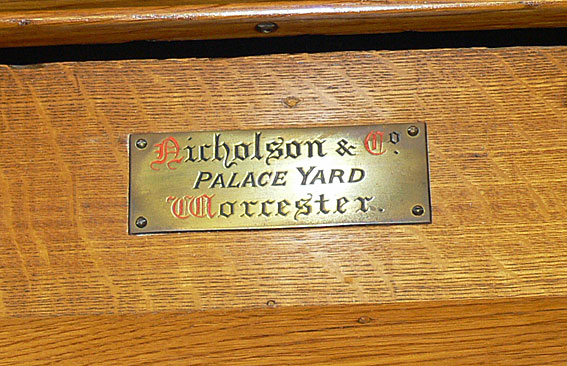
St Paul's Anglican Church, Stockton:
The Nicholson & Co. organ: nameplate
[photograph by John Maidment (28 September 2015)]

St Paul's Anglican Church, Stockton:
The Nicholson & Co. organ: left-hand stop jamb
[photograph by John Maidment (28 September 2015)]
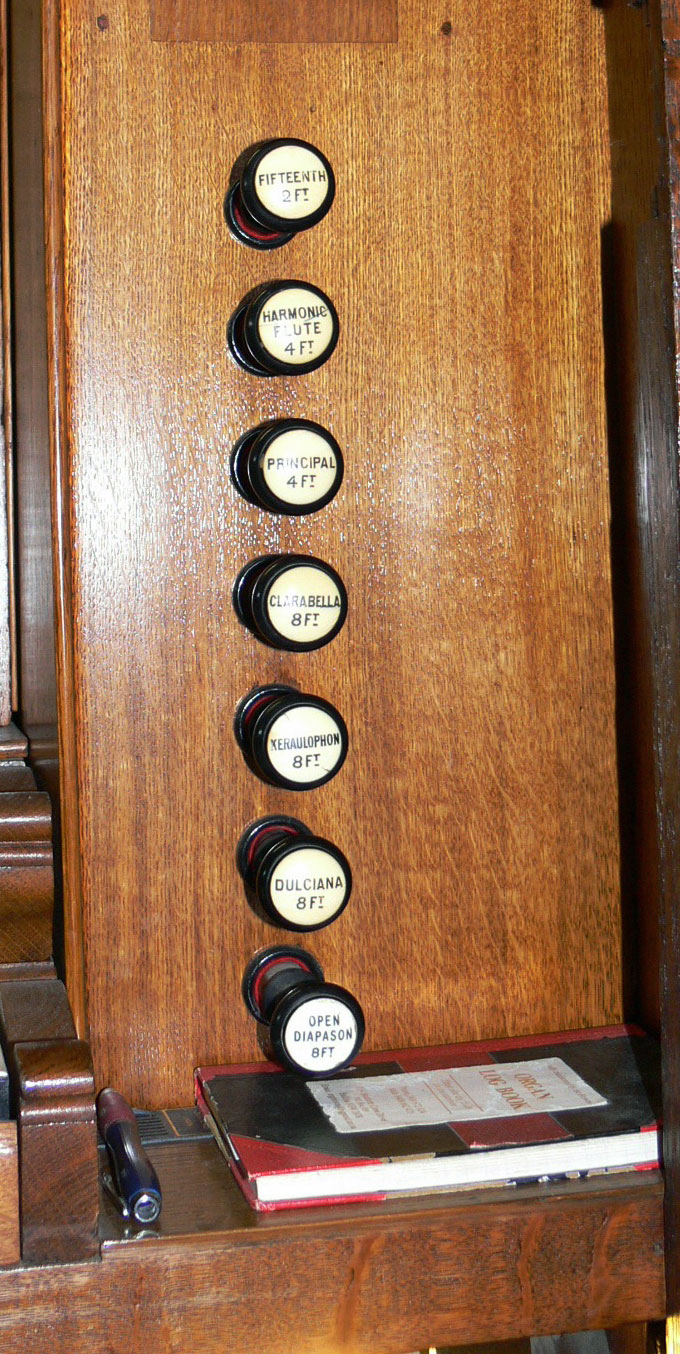
St Paul's Anglican Church, Stockton:
The Nicholson & Co. organ: right-hand stop jamb
[photograph by John Maidment (28 September 2015)]
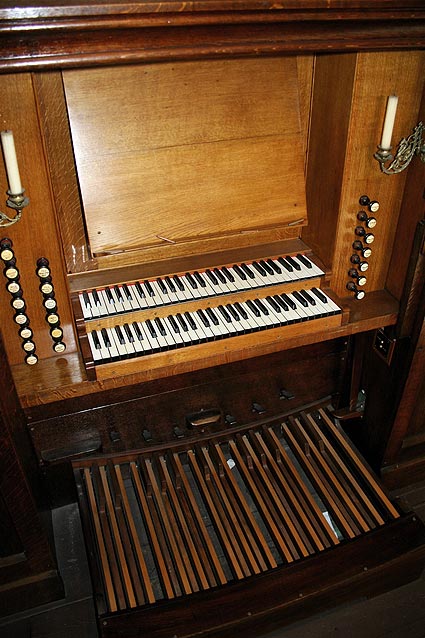
St Paul's Anglican Church, Stockton:
The Nicholson & Co. organ: console
[photograph by Trevor Bunning (July 2007)]
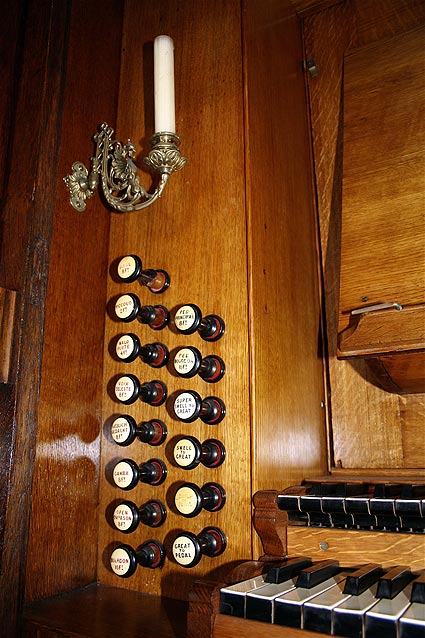
St Paul's Anglican Church, Stockton:
The Nicholson & Co. organ: left-hand stop jamb
[photograph by Trevor Bunning (July 2007)]
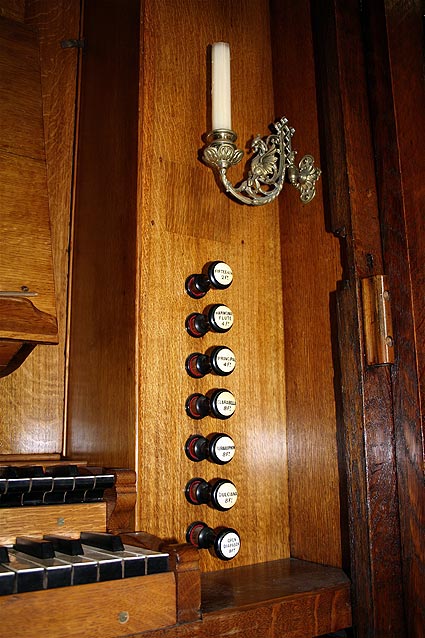
St Paul's Anglican Church, Stockton:
The Nicholson & Co. organ: right-hand stop jamb
[photograph by Trevor Bunning (July 2007)]
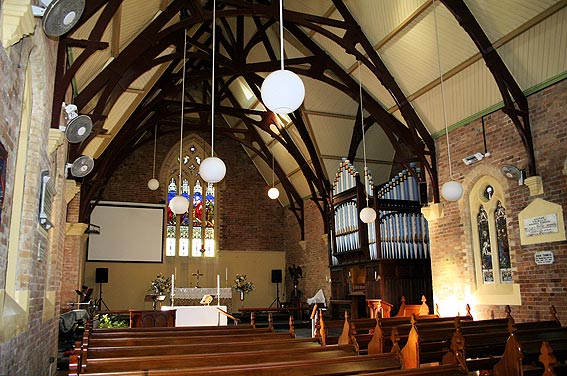
St Paul's Anglican Church, Stockton:
The Nicholson & Co. organ: church interior
[photograph by Trevor Bunning (July 2007)]
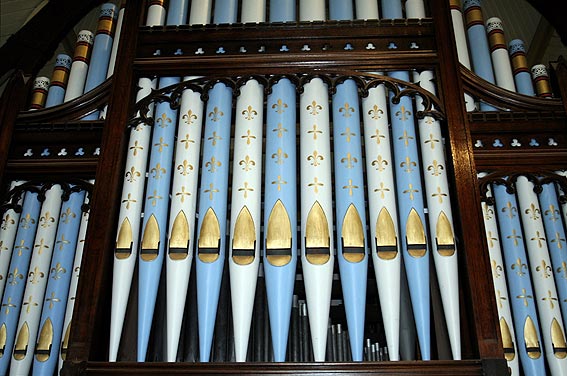
St Paul's Anglican Church, Stockton:
The Nicholson & Co. organ: close-up of façade
[photograph by Trevor Bunning (July 2007)]
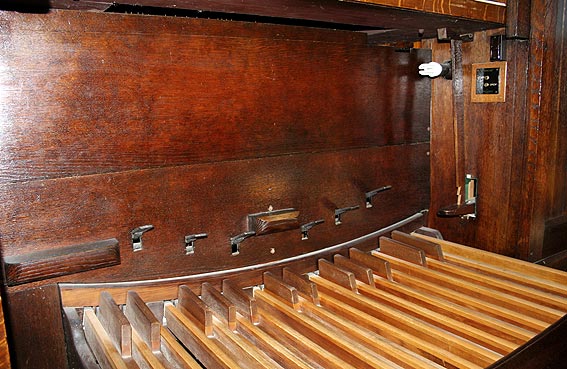
St Paul's Anglican Church, Stockton:
The Nicholson & Co. organ: pedalboard
[photograph by Trevor Bunning (July 2007)]